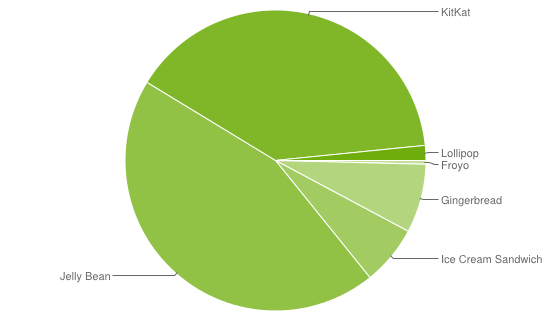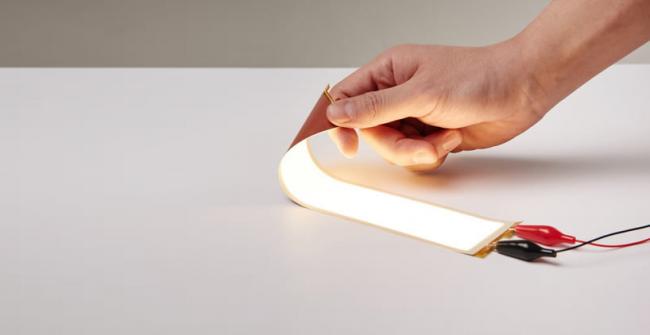
Technology Observatory February 2-8
Welcome another week to the Technology Observatory. A review of the most relevant technological news of last week:
● Samsung Gear VR already has an arrival date set for Spain
● The Samsung Galaxy S6 will be presented on the 1st of March
● 1.6% of Android devices are already updated with Lollipop
● Telegram upgrades by including extensions and interactive notifications in iOS
● Google gets ready to launch its own Uber
● Uber starts its autonomous vehicle project
● LG has prepared the flexible OLED that's as thin as a sheet of paper
● Pepephone already has 4G through Movistar
● Microsoft will halt the manufacturing of the Nokia Lumia 2520
● Bq will reveal its first device based on Ubuntu next February 24th
● Tuenti Móvil does without the SIM, allowing for making calls without it from different devices

Remember the Samsung Gear VR? It was presented at IFA 2014, together with Note 4 and Note Edge, and is Samsung's landing to virtual reality by the hand of those who first made this technology appealing for the first time in many years: Oculus Rift. A few months after its presentation, Samsung has announced the availability of the Samsung Gear VR in Spain as of February 13th through the Samsung Shop. It is especially designed, given its screen size/resolution/density for the Galaxy Note 4, without a doubt the best smartphone presented by Samsung in 2014 and one of the year's best terminals. It will cost €249. This can be a very attractive product for gaming at home, but to date faces a problem: the quantity, quality and duration of the contents available for the Gear VR. We'll be watchful as months go by as to the possible arrival of more games and entertainment applications compatible with this product.

Samsung has started to send out its media invitations for the event at which it is almost certain it will present the new flagship of this South Korean company, the long-awaited Samsung Galaxy S6. According to Phonearena, the Samsung Unpacked 2015 will take place on March 1st, within the framework of the Mobile World Congress to be held then in Barcelona. As appears in the image on the invitation, in addition to the Galaxy S6 it is likely that Samsung will present another curved phone with a metal edge, in line with the Galaxy Note Edge. Rumors about another curved phone by Samsung is something we've been hearing for some time now, therefore this hint given by the South Korean giant comes as no surprise. As to the real smartphone actually expected, its arrival comes at a difficult time for the company, as its most recent financial report has revealed. It is expected that the Galaxy S6 will be that mobile that will not only bring with it a great leadership as regards sales, but will also entail many improvements to the Galaxy S5, especially in software optimization and in the attention to detail and materials. The second is something we saw with the Galaxy Alpha and now with the Galaxy A3, A5, A7 and which will surely be improved in the Galaxy S6. It is expected that the Galaxy S6 will arrive with a new screen size close to 5" with QHD (2560 x 1440 pixels) resolution. As to its processor, on this occasion it is likely that Samsung will bet on its Exynos processors, at least as its first option, something that had not happened since the Galaxy S3. The chosen model would be the Exynos 7420 with 8 cores, manufactured in 14nm. Last of all, as happened in the Galaxy S5 with ISOCELL, we expect that Samsung will manufacture the camera sensor in a solution offering 20 megapixels.

Thanks to new data on the distribution of Android versions that Google has just published, we finally know the penetration of the latest version of the operating system launched in the market already over two months ago. With data on devices that connected to Google Play in the last seven days, we know that Android 5.0 Lollipop is already installed in 1.6% of devices, which, the same as occurred with previous versions, starts off by increasing slowly and will surely grow quickly when more manufacturers launch their updates and new devices including this new version as standard. As to the previous versions, Android 4.4 KitKat, together with Lollipop, are the versions gaining market share, growing from 39.1% to 39.7%. The rest of the already outdated versions continue to lose market presence. Android 4.3 is in 6.3% (before 6.5%), Android 4.2 is in 19.8% (before 20.3%), Android 4.1 is in 18.4% (before 19.2%), Android 4.0 is in 6.4% (before 6.7%), Android 2.3 is in 7.4% (before 7.8%) and Android 2.2 remains the same in 0.4%.
Telegram, one of the best messaging applications, moves forward in its fight to steal market share from the dominant WhatsApp. How? Simply by not abandoning its users and by updating its application with improvements and innovations that always enrich the experience. This time, Telegram reaches version 2.9, just two months after its most recent update, where we again find interesting innovations for daily users of this application, like support for iOS 8 extensions, interactive notifications, larger file size for sending, amongst others we will disclose below. The first change is that now, when we receive a message in Telegram, we can "pull" from the notification, shaped like a strip, to drop down additional options, such as to respond or silence the conversation for eight hours. On another hand, we now have support for iOS 8 extensions, with which we will be able to send links, photos and videos from any application directly to Telegram without needing to open the application, as long as it supports the extensions, obviously. Likewise, now the size for sending and receiving files increases to 1.5 GB, ideal if we want to send a large file using a desktop application or other platforms. Remember that, to date, we don't have a file manager in iOS. In addition, now it will be possible to consult all of the files received using the "Shared Multimedia" option in the information on conversations. Finding elements in the application is now simpler, as Telegram improves searching by including users, groups, files and even words in the conversations. Last of all, we can silence conversations through the information on conversations, choosing amongst one, eight or two days. Of course, the classic improvements of performance and repaired failures that were detected in previous versions are also included. Telegram 2.9 is already available at no cost in the App Store and is compatible with all iOS devices as of version 6.0, but to be able to use the extensions and interactive notifications at least iOS 8.0 is required.
Google could be about to jump into a new market, that of public transportation. As reported by Bloomberg, the internet giant is in the process of launching "its own Uber", a transportation network that communicates using its own application by improving the style of this startup that, for better or for worse, has become so famous worldwide in recent years. What is most curious is that Google invested in 2013 no less than $258 million in Uber, the greatest investment ever made by Google Ventures (division dedicated to financing and promoting startups) to date. Now, instead of continuing as one of Uber's most important investors, it is preparing to compete against it. An anonymous information source assures to have been present in the conversations held between the Board of Directors of Uber, of which David Drummond, Vice President of Corporate Development at Google, is a member, who informed the Board of the decision made by the company in Mountain View to delve into this world with its own service. For now, no details are available on Google's plans, but if Bloomberg's information is true, this could even relate to the company's autonomous vehicles. Just imagine what it would be like to request a taxi using the application, be picked up by a driverless vehicle that takes us to our destination, with the service charged to our credit card. The idea is between futuristic and incredible, and it's obvious that Google wants to be omnipresent in everything, like another company we know…
Uber is one of those companies that renders a great service that to date we did not think was possible (at least not in this way), but which has been engulfed by controversy, whether by the rejection of its proposal by governments and the taxi sector, or by scandals that are started by its own employees (such as the case of its peculiar vehicle tracking system). Uber, on another hand, announces in its official blog a tremendously ambitious news item that could change a lot of things in the world of public transportation. On another hand, this could be the beginning of the worst nightmare for taxi drivers. If you're the type that has nightmares about robots taking over the jobs of humans, you can start worrying... Uber starts its autonomous vehicle project. Yes, taxis that drive by themselves, pick you up and take you to your destination, with no one behind the wheel aside from the automatic driving system that is being designed right now by Carnegie Mellon. It's a highly ambitious plan that is not expected to become reality until many years go by, perhaps one or two decades, but they have already started to invest in this, just like Google with its own version of Uber that will use autonomous vehicles. Is the future already here?

Some time ago, we witnessed how a small startup was bold enough to create a flexible plastic OLED panel as thin as a sheet of paper. It's a promising technology on which several companies are working, including LG that recently announced that it's not only involved, but furthermore that it planned to mass-produce them to sell to different partners. The Koreans have already been developing this technology, but have taken a major step forward in this second generation: they have moved beyond glass to launch plastic models. The bending limit of the first generation was limited to 75 mm, while with this material the second generation increases its radius 30 mm, preventing it from breakage if too much force is applied. Why has the switch to plastic occurred now and not before? To have the technology ready to maintain the same efficiency levels for brightness and the color rendering index. To overcome this obstacle, an encapsulation technology has been used that grants these OLED panels an efficiency of 60lm/W, 75 lm of brightness and color at a temperature of 3,000 degrees Kelvin with a color rendering index above 85. The factory LG uses to manufacture these is ready to create samples with the abovementioned specifications, as well as large shipments of OLED panels sized 320 x 320 mm with a thickness of 0.88 mm, and the following capabilities: 60lm/W, color rendering index above 90 and a luminosity of 800lm with 8.5V and 1.600 mA. Adding power, it is capable of reaching 1.200 lm. Production will begin this first quarter of the year at a price of $680 though this figure may decrease, depending on the volume of the order made to the factory.
Pepephone starts as of February 3rd to migrate the lines of its clients of the Vodafone network over to the Movistar 4G network in a process that will last several months and which will be completed in chronological order as per contract issue dates. Pepephone already has 4G through Movistar: the telecommunications operators reached an agreement for using the network last September. However, the complexity of the process has delayed the start of the migration until now, when after a few weeks for testing it will begin. Pepephone expects to migrate all of its lines by summer. Clients will continue to have their line available the entire time, may use it as normal during these months, and the rates and conditions of use will remain the same. The migration requires changing from a Vodafone to a Movistar SIM card. Pepephone will mail the new cards to all of its clients. Upon receipt, a client must access the company web, enter the “My Pepephone” section and follow the instructions given on the screen. This migration-related section will be unavailable to the user until his or her SIM has been mailed. Upon completion of the process, the client will be notified of the migration date or will be assigned a new one in case of problems. If a client needs to make a change in advance, he or she must simply dial 1212 and press 1 while listening to the recording to request moving higher up in the migration list. In addition, all new clients who become Pepephone users as of February 4th will already have their Movistar SIM and access to the 4G network.
Together with the most recent news that Microsoft was going to stop the development of the Surface 2, now comes the announcement that it will also halt the manufacture of the Nokia Lumia 2520, the tablet with Windows RT presented by the company from Finland. Though no official comments have been made, it is obvious that what all of this reveals is that Microsoft is ruling out the Windows RT operating system. Moreover, this makes sense, given that with the new version of Windows 10, available in all terminals, the existence of Windows RT is no longer necessary. For now, we don't know if this tablet’s manufacturing process has been frozen or if it will end in the future, as the official Microsoft page continues to sell it at a price of $499 with a 2-year Verizon contract. As to updates, no device with Windows RT will receive Windows 10. Instead, an update will be available that includes some of the functionalities of the newest Microsoft operating system (something similar to what happened with Windows Phone 7.8, which received some features of Windows Phone 8).

It's been almost a year now that we discovered that Canonical had reached an agreement with two manufacturers to launch the first terminals based on Ubuntu. One of these companies is no other than bq, and its managers have officially confirmed that its first smartphone based on Ubuntu will be presented next February 24th. It is highly likely that the terminal by bq will be the first in the world that is officially distributed with this operating system. For now Meizu, the second manufacturer with which Canonical has been collaborating, has not disclosed any data on the presentation of this terminal, with which its managers are also involved. The terminal chosen for distribution with Ubuntu is the bq Aquaris e4.5, an entry-level range device that is modest yet interesting for trailing its path in an ultracompetitive market. There are many unknowns as to the user experience that this terminal can offer, and we'll see if both Canonical and bq will be able to overcome the hesitations that this alternative to traditional platforms posed when the preliminary edition of the Ubuntu Touch saw the light last year.
Its rates can be more or less attractive, but what's undeniable of Tuenti Móvil is that it is one of the most innovative telecommunications operators, thanks also to the backing it has by Telefónica. This is how we came to know of innovative services in a single telecommunications operator, like VozDigital, that permits for making IP Voice calls to any number nationwide. But the announcement made today by Tuenti Móvil is that it climbs another step higher, as the telecommunications operator is literally moving to a cloud. In its next update, to reach AppStore and Google Play in a few days, the Tuenti Móvil application will allow for Digital Voice calls from any device, without requiring the use of the telecommunications operator's SIM card. With each passing day, Tuenti becomes less social network-based and more of a virtual telecommunications operator. In fact, as of now, when its users enter the web, they will directly access their cellphone account with the chats on one side. However, the most important innovation presented by Tuenti is not that, but rather the possibility for making IP Voice calls without a SIM card. The hottest news of the day is that the next update of its application will allow the users of its cellphone service to make calls from any compatible device, without requiring an inserted SIM card. It will suffice to identify ourselves in the app with our user name and password to make IP Voice calls. Accessed this way, the user will access his or her contacts and when making the call the receiver will have the user's number displayed on the screen, even if the call is being made from another phone or without the SIM card. The application will also be partly redesigned, with contacts using round avatars and with clearer chats. Without neither having seen the updated application nor having tested it, I can think of several situations in which this innovation of making a call from other devices can be quite useful. From being able to communicate when our phone's battery has run dead, or being able to use the same number in different phones, the move to the cloud by Tuenti Móvil seems quite interesting and promising.
